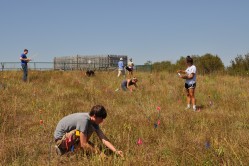Press Release, 14. January 2016
New evidence that diversity has a positive effect on biomass production
Leipzig/Halle (Saale). Communities rich in species are substantially healthier and more productive than those depleted of species. An international group of scientists has solved this long-standing ecological riddle using new scientific techniques for analysing complex data of grassland ecosystems worldwide. The study with participation of the Helmholtz Centre for Environmental Research (UFZ), the German Centre for Integrative Biodiversity Research (iDiv) and the Martin Luther University Halle-Wittenberg is published today in the current issue of "Nature". It is the most comprehensive study up to now, which shows this effect in natural, un-manipulated ecosystems.

Photo: Ramesh Laungani, Doane College
The biodiversity and productivity of ecosystems are important to human well-being and, at the same time, are highly impacted by human activities. The relationship between biodiversity and productivity remains a fiercely debated topic due partly to numerous, often conflicting underlying theories. Biodiversity has been hypothesized to be of critical importance for the stability of natural ecosystems and their abilities to provide positive benefits such as oxygen production, soil genesis, and water detoxification to plant and animal communities, as well as to human society. Many of the efforts of conservation agencies around the world are driven by the assumption that this hypothesis is true. While theoretical studies have supported this claim, scientists have struggled for the last half-century to clearly isolate such an effect in the real world.
To determine this the scientists used data collected for this research by a global consortium, the Nutrient Network, from over a thousand grassland plots spanning five continents. The network is coordinated by the University of Minnesota and examines natural meadows and pastures ecosystems at more than 70 locations worldwide research. In Germany plots near Papenburg (Lower Saxony), Jena (Thuringia) and Bad Lauchstädt (Saxony-Anhalt) are part of the network. For the study, the team evaluated data from 1126 plots on 39 grasslands. Using recent advances in analytical methods, the group was able to isolate the biodiversity effect from the effects of other processes, including processes that can reduce diversity. "This study shows that you cannot have sustainable, productive ecosystems without maintaining biodiversity in the landscape," says Professor James Grace of the US Geological Survey, who led the study.
A key finding of this paper is the positive effect that greater plant species diversity had on biomass production; this confirms extensive experimental results, but showing this effect in natural, un-manipulated systems has been a challenge until now. "Impressively, the multivariate structural equation model explained more than 60% of the variation is plant species richness in these natural ecosystems. Furthermore, the underlying environmental drivers of biodiversity and richness differed, which has important implications for understanding diversity and productivity patterns at a global scale", says Professor Stanley Harpole of UFZ/iDiv/MLU. He is one of the founders of the Nutrient Network.
The researchers found also strong and independent influences of macroclimate and soils on richness and productivity. If climate change leads to reduced species or genetic diversity, which is a real possibility, that then could lead to a reduced capacity for ecosystems to respond to additional stresses.
The new published results provide a rigorous framework towards experimentally testing the causal mechanisms that allow species to coexist and for ecosystems to provide the services that we depend on. A take-home message is that only by using theory-based multivariate causal modelling approaches, can we move towards predicting the multiple and interacting effects of human-driven global change.
Publication:
James B. Grace, T. Michael Anderson, Eric W. Seabloom, Elizabeth T. Borer, Peter B. Adler, W. Stanley Harpole, Yann Hautier, Helmut Hillebrand, Eric M. Lind, Meelis Pärtel, Jonathan D. Bakker, Yvonne M. Buckley, Michael J. Crawley, Ellen I. Damschen, Kendi F. Davies, Philip A. Fay, Jennifer Firn, Daniel S. Gruner, Andy Hector, Johannes M. H. Knops, Andrew S. MacDougall, Brett A. Melbourne, John W. Morgan, John L. Orrock, Suzanne M. Prober & Melinda D. Smith (2016): Integrative modelling reveals mechanisms linking productivity and plant species richness. Nature (14 Jan 2016). doi:10.1038/nature16524 http://dx.doi.org/10.1038/nature16524
The study was founded by the US Geological Survey, the National Science Foundation (NSF) (Research Coordination Network (NSF-DEB-1042132) & Long Term Ecological Research (NSF-DEB-1234162 to Cedar Creek LTER) programs) as well as the UMN Institute on the Environment (DG-0001-13).
The current issue of Nature published also a comment (N&V article):
Kevin Gross (2016): Biodiversity and productivity entwined. Nature (14 Jan 2016). doi:10.1038/nature16867 http://dx.doi.org/10.1038/nature16867
Links:
Nutrient Network (NutNet)
http://www.nutnet.umn.edu/
http://environment.umn.edu/biodiversity/nutnet-new-model-for-global-research/
Further information
Prof. Dr. Stanley W. Harpole
US Geological Survey, Lafayette, Louisiana (US)
Phone: +49 341 97 33171, -33152
Prof. Dr. James Grace
US Geological Survey, Lafayette, Louisiana (US)
UFZ press office
Susanne Hufe
Phone: +49 341 6025-1630
presse@ufz.de
In the Helmholtz Centre for Environmental Research (UFZ), scientists conduct research into the causes and consequences of far-reaching environmental changes. Their areas of study cover water resources, ecosystems of the future, environmental technologies and biotechnologies, the effects of chemicals in the environment, modelling and social-scientific issues. The UFZ employs more than 1,100 staff at its sites in Leipzig, Halle and Magdeburg. It is funded by the Federal Government, Saxony and Saxony-Anhalt.
www.ufz.deThe Helmholtz Association contributes to solving major challenges facing society, science and the economy with top scientific achievements in six research fields: Energy; Earth and Environment; Health; Key Technologies; Matter; and Aeronautics, Space and Transport. With some 39,000 employees in 19 research centres, the Helmholtz Association is Germany’s largest scientific organisation.
www.helmholtz.de